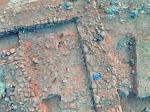Summary (English)
EXPLORATIONS NEAR THE VILLAGE OF KNYAZHEVO (Daniela Agre – daniela.agre@abv.bg, Deyan Dichev) The southern half of Room 2 in Building No. 4 was explored. Its western wall was 1.10 m wide and served as the fortification wall of the Thracian tyrsis (residential tower). The eastern wall of the room was 1 m wide and had an entrance towards Room 3. A drachma of Antigonus I Monophthalmus minted in Lampsakos and a bronze coin of Lysimachus were found in the layer with traces from fire spread over the floor of Room 2. The coins testified that the fire that destroyed the complex occurred during 300 – 275 BC. Sherds from Thracian pottery, Greek amphorae and black-gloss pottery were found outside the northern fortification wall. The excavations of the ditch in front of the southern fortification wall continued. Sherds, fragmentary building ceramics and a layer with ash and charcoal were discovered in that area. A pit was discovered in front of the drainage channel in the fortification wall to drain the water from the room with the bathtub and the Central Building towards the ditch. Cut stones were discovered in the Central Sector, to the east of Building No. 2 and in front of its stylobate, probably supporting a timber column. A pit was discovered, containing fragmentary building ceramics, sherds, pieces of slag and iron ore, and fragmentary architectural details, probably from the stylobate of Building No. 2. The pit was probably related to the iron ore smelting furnaces that functioned during the second occupation period. Fragmentary building ceramics, sherds from Greek amphorae, pieces of iron ore, slag and charcoal were found in the eastern ditch. A pit was discovered to the north of the Central Building, containing fragmentary sun-dried bricks, sherds from Thracian and Greek pottery, including amphorae, fragmentary building ceramics, pieces of slag and a bronze coin. The pit dated to the second occupation period (275 – 250 BC) and probably it was a ramshackle sunken-floored house occupied by the people dealing with metallurgy.
- Daniela Agre - Archaeological Institute with Museum
- Deyan Dichev - Archaeological Institute with Museum
Director
- Daniela Agre - Archaeological Institute with Museum
- Deyan Dichev - Archaeological Institute with Museum
Team
Research Body
- Archaeological Institute with Museum






![Download [PDF]](/excavation/skins/fasti/images/results/download_sml.png)